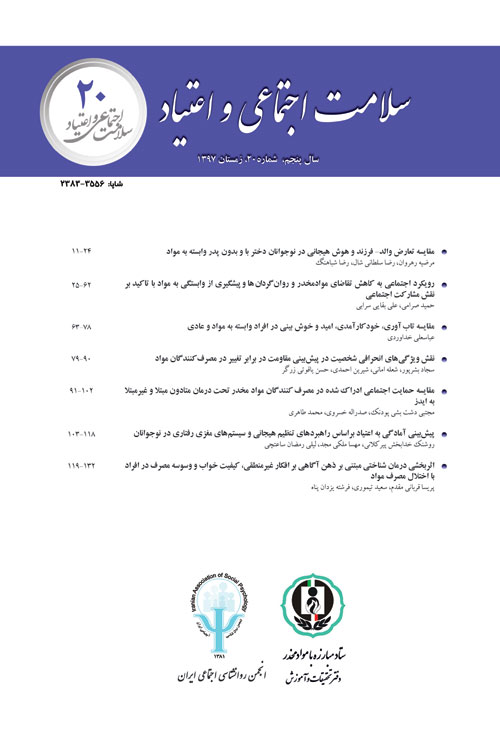Sexual Addiction and its Comorbidity with Substance Dependence
Author(s):
Abstract:
Sexual addiction is characterized by persistent and intense sexual thoughts and acts that have a negative impact on individuals’ life. Sex addicts make many attempts to control or postpone sexual feelings and acts, but these attempts fail. Sexual addiction is not influenced by a specific causal factor, and it is thought that different biological, psychological, and social factors play a role. Like other psychiatric conditions, sexual addiction has comorbidity with mental disorders that are more prevalent in some groups, including sex offenders, individuals with infectious diseases (HIV/AIDS), and substance use disorders. The purpose of the present study was to investigate sexual addiction and its comorbidity with substance dependence using documentary study method. In this study, various challenges and controversies emerged since the rise of sexual addiction in research and clinical literature were explained. Neurobiological bases of addictive sexual behaviors, substance use disorders, and their comorbidities were also provided. In the therapeutic dimension, research and clinical studies have pointed to the widespread use of psychoactive agents for the treatment of sexual addiction, and in a number of other approaches, both pharmacotherapy and psychotherapy have been suggested for the treatment of people with sexual addiction. Sexual addiction is expressed through sexual behaviors and addictive processes, and both sexual behaviors and underlying addictive processes must be addressed to treat it. There are significant gaps in the existing scientific knowledge regarding in past, present, and predictive validations for sexual addiction or sexual hyperactivity disorder. Similar to many other psychiatric disorders, the current situation and the challenges associated with sexual addiction and its comorbidity with other disorders (especially substance use disorders) require further research to fully elucidate this disorder.
Keywords:
Language:
Persian
Published:
Social Health and Addiction, Volume:6 Issue: 21, 2019
Pages:
77 to 96
magiran.com/p2009847
دانلود و مطالعه متن این مقاله با یکی از روشهای زیر امکان پذیر است:
اشتراک شخصی
با عضویت و پرداخت آنلاین حق اشتراک یکساله به مبلغ 1,390,000ريال میتوانید 70 عنوان مطلب دانلود کنید!
اشتراک سازمانی
به کتابخانه دانشگاه یا محل کار خود پیشنهاد کنید تا اشتراک سازمانی این پایگاه را برای دسترسی نامحدود همه کاربران به متن مطالب تهیه نمایند!
توجه!
- حق عضویت دریافتی صرف حمایت از نشریات عضو و نگهداری، تکمیل و توسعه مگیران میشود.
- پرداخت حق اشتراک و دانلود مقالات اجازه بازنشر آن در سایر رسانههای چاپی و دیجیتال را به کاربر نمیدهد.
In order to view content subscription is required
Personal subscription
Subscribe magiran.com for 70 € euros via PayPal and download 70 articles during a year.
Organization subscription
Please contact us to subscribe your university or library for unlimited access!



